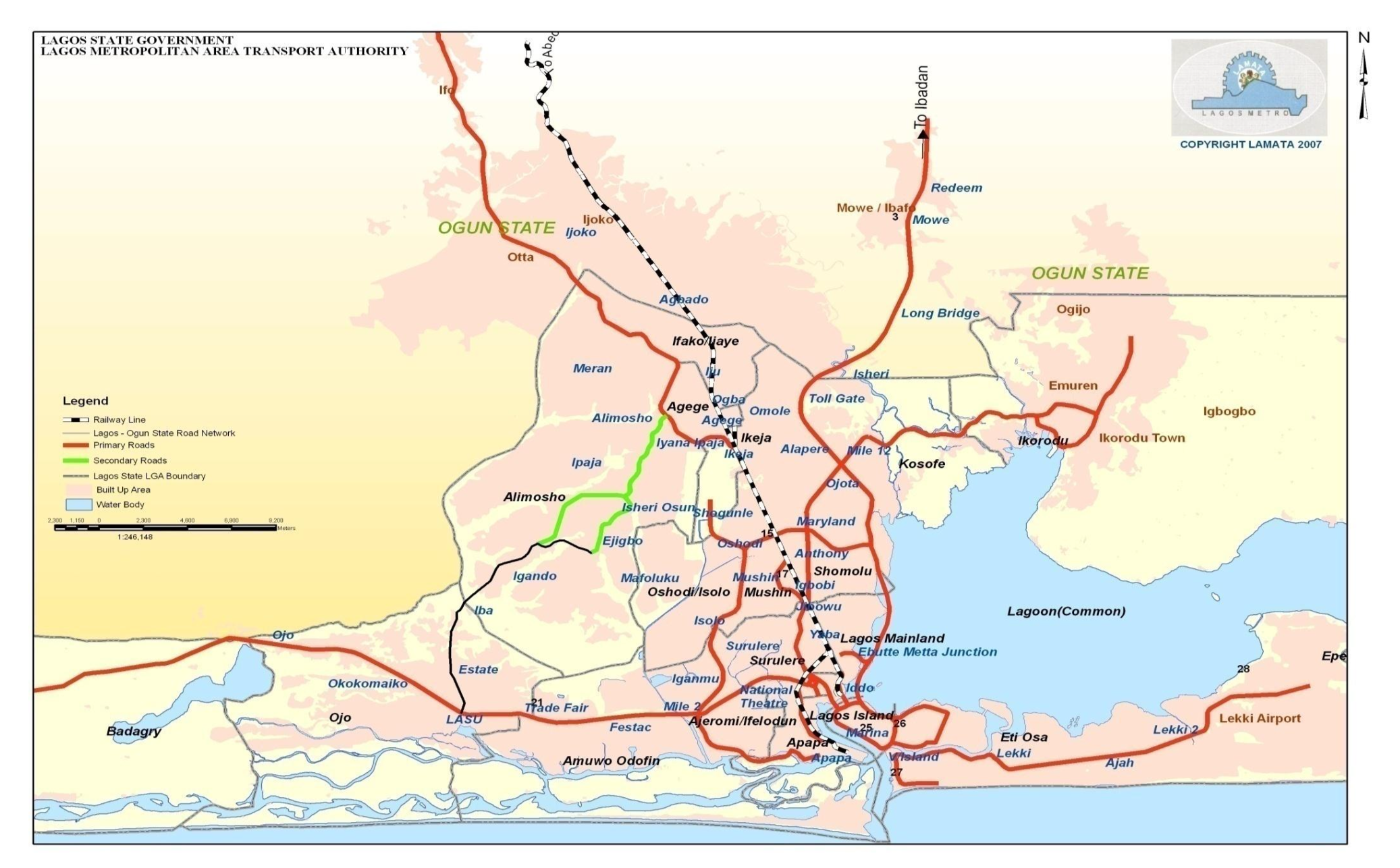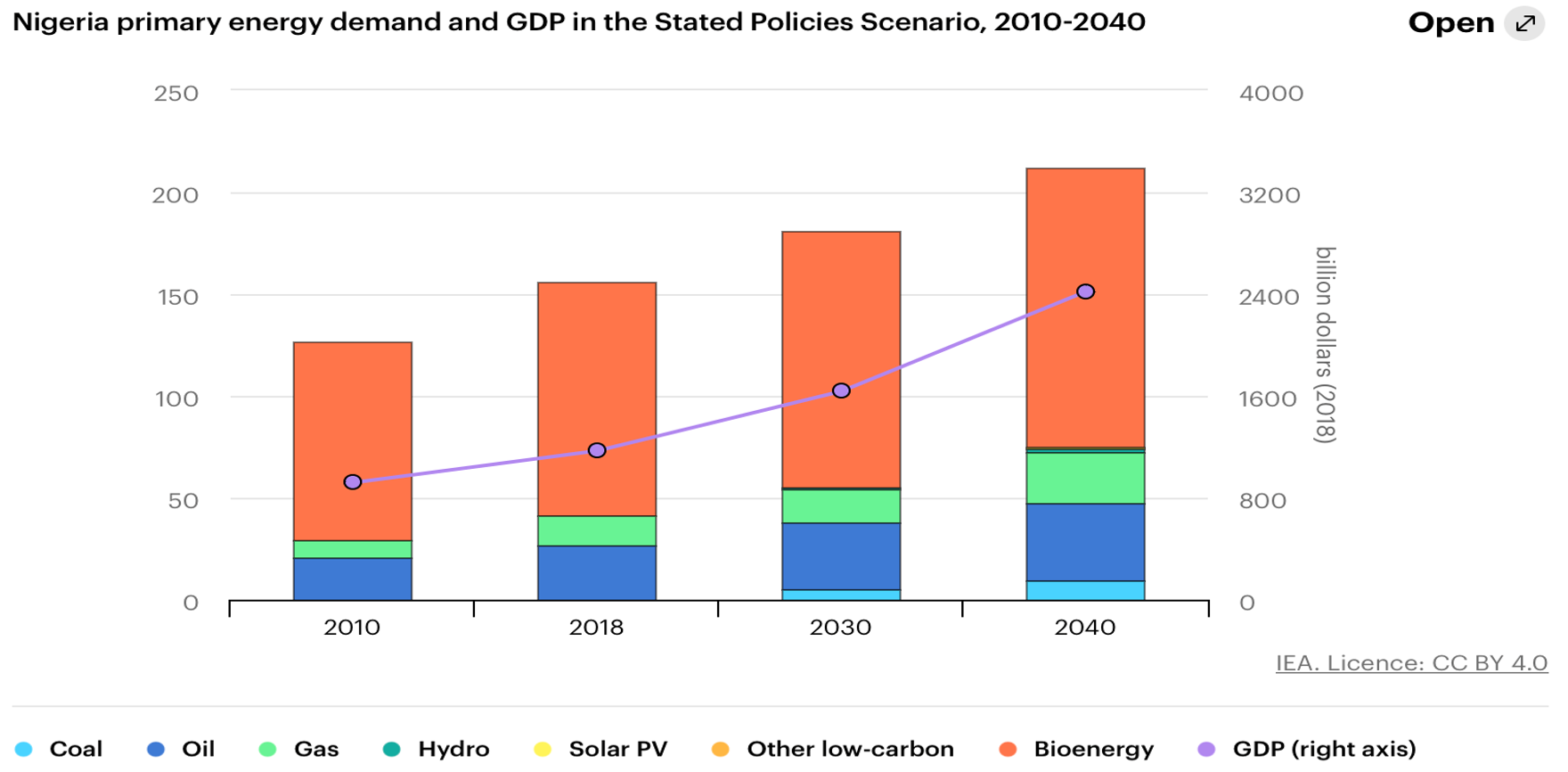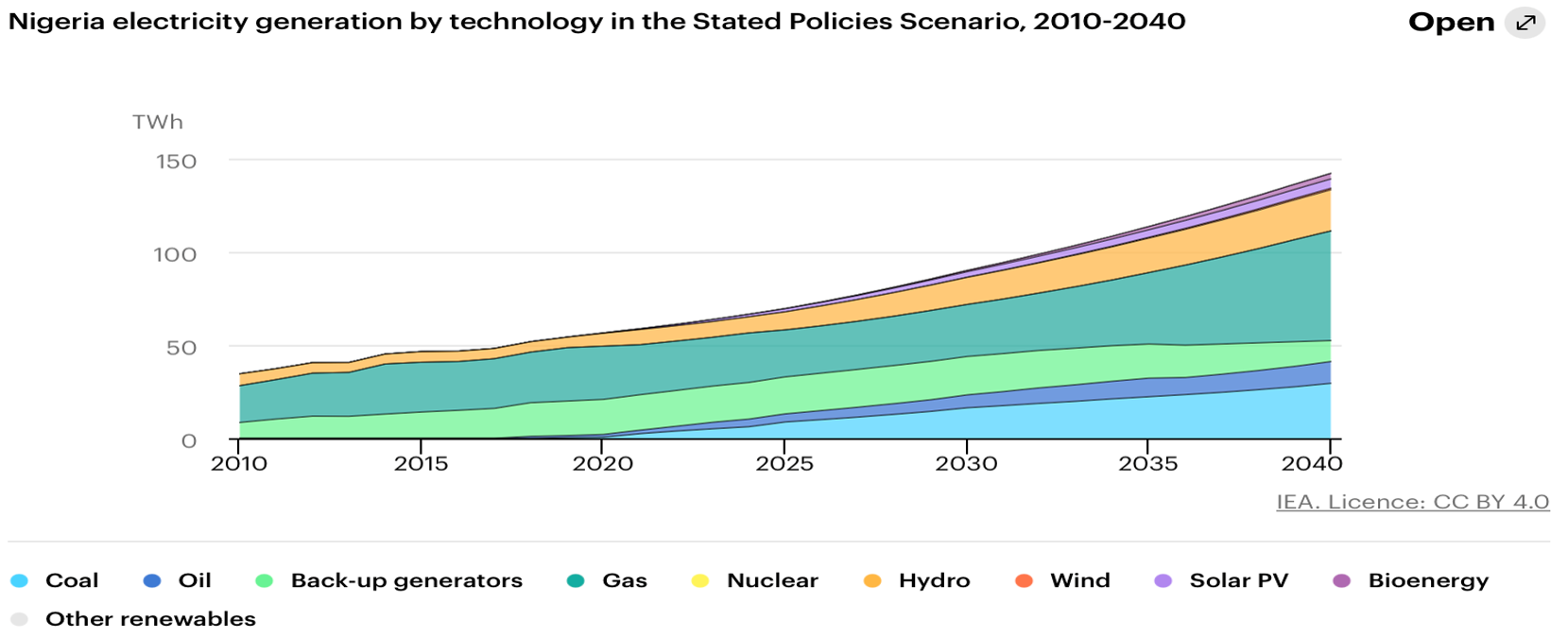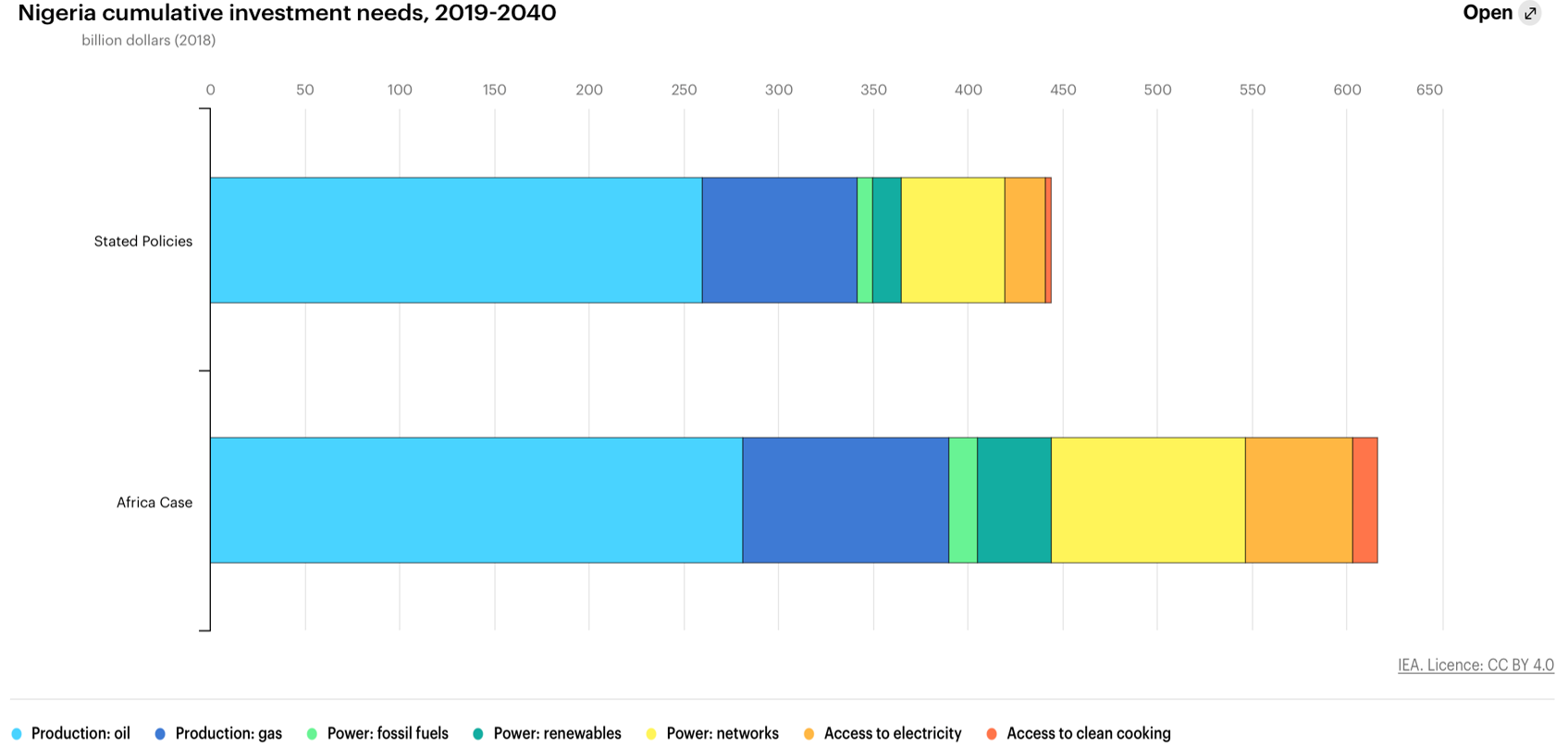1. Introduction
Lagos, Nigeria, has a population of over 21 million. Currently, Lagos’ transportation system relies mainly on traditional fuel-powered vehicles. Global warming and public health issues, especially carbon emissions and air pollution, have become focal concerns in many major cities around the world. This paper aims to explore the potential impacts that the introduction of electric vehicles in Lagos, Nigeria, may have on air quality, carbon emissions, and energy infrastructure.
2. Background introduction of road traffic
Lagos holds the status of being both the commercial and economic hub not only for Nigeria but for the entire African continent. The population is estimated at 21,305,971 and the total land area is 3,577.28 km², of which approximately 22% is wetland area. The population density is approximately 6,515 persons per square kilometre . The existing transport network in Lagos is shown in Figure 1. The two main sources of traditional transportation fuel in Nigeria are petrol and diesel, which account for almost all vehicles operating in the country . As of 2019, the total number of newly registered motor vehicles in Lagos State was 154,056, of which private-use motor vehicles accounted for 82.5% of the total, reaching 127,058 vehicles. Passenger transportation mainly relies on buses (44.8%) and cars (42.5%). Overall, more than 61% of trips are by gasoline vehicles, while the remainder are by diesel vehicles . This situation makes Lagos a region with high carbon emissions, and according to projections, its greenhouse gas emissions may reach a staggering 39 MtCO2 equivalent by 2040 . Therefore, the conversion of private cars in Lagos to electric vehicles is very necessary for the ecological environment.

Figure 1. Existing Transport Network .
The low quality and poor state of the current road infrastructure in Lagos has adversely affected the development of the city. By replacing traditional gasoline-powered vehicles with electric vehicles (EVs), it is expected to improve living and working conditions in the region to a certain extent . However, However, purchasing electric vehicles for private use still faces high costs, as approximately 40.1% of Nigeria’s population still lives below the poverty line . In light of this, the government of Lagos, Nigeria may implement a range of policies and incentives to encourage ordinary citizens to acquire EVs and thus, bolster the market share of this sustainable form of transportation.
3. Analysis of energy requirement for vehicles

Figure 2. Nigeria primary energy demand and GDP in the Stated Policies Scenario, 2010-2040 .
In sub-Saharan Africa, factors such as rapid urbanization, the promotion of decentralized solar photovoltaic technology, and the increasing popularity of electric transportation are reshaping power planning options . If the electricity used to charge the car comes from renewable sources such as solar or wind, the car’s overall carbon footprint can be significantly reduced. The Nigeria primary energy demand and GDP in the Stated Policies Scenario from 2010 to 2040 is shown in Figure 2. From the figure, we can see that with the improvement of economic level, Nigeria’s demand for various energy sources has also increased significantly. Therefore, the Lagos government also needs to gradually expand the proportion of renewable energy, which has a major impact on the country’s future development.
3.1. Current Energy Consumption
As the modern technological revolution continues to advance, the continued growth of the global population has led to a sharp increase in electricity demand, which has raised a problem that urgently requires sustainable energy solutions . In Nigeria’s power sector, the vast majority of electricity supply relies on fossil fuels, especially natural gas, which accounts for approximately 80% of total fossil fuel energy. In fact, about 80% of the country’s energy structure comes from thermal power generation, while the remaining 20% comes from hydropower and other renewable energy sources . The Nigeria electricity generation by technology in the Stated Policies Scenario from 2010 to 2040 is shown in Figure 3. As can be seen from the figure, it is expected that the government of Lagos, Nigeria will gradually increase the supply of renewable energy in the future. This will improve the current problem of insufficient electricity and the high proportion of fossil energy.

Figure 3. Nigeria electricity generation by technology in the Stated Policies Scenario, 2010-2040 .
As of 2020, Nigeria’s transportation industry accounts for more than 70% of the country’s energy consumption. Nigeria and other countries are actively taking measures to reduce greenhouse gas (GHG) emissions, which cause serious climate and environmental problems . Switching to electric vehicles in Lagos, Nigeria could reduce dependence on imported fossil fuels and improve energy security. With fossil fuels becoming increasingly scarce and environmental awareness growing, using fossil fuels could become increasingly costly in the future, and switching to electric vehicles could reduce the economic cost.
3.2. Future Energy Supply
Nigeria is located between 4° and 14° north latitude (slightly north of the equator) and between 2° and 15° east longitude (slightly east of the prime meridian). The entire country is in sunny areas . Solar power can provide a sustainable solution to long-term energy needs. While the initial equipment cost of solar power generation may be steep, its operational expenses are considerably lower. This can potentially lessen the reliance on fossil fuels such as oil and natural gas, thereby lowering energy expenses in Lagos. The government of Lagos should intensify efforts to advocate and implement solar power generation technology to foster sustainable development. Lagos has a huge energy demand, but the energy supply is unstable. Both solar and hydroelectric power can provide Lagos with a clean, renewable and stable electricity supply.
3.3. Action taken by the Government
The Nigerian government is actively working to reduce noise and air pollution, and a key measure is promoting the use of electric vehicles (EVs). To achieve this goal, the government has incorporated the popularization of electric vehicles into the national automobile industry development plan . Faced with frequent power shortages in Nigeria that affect the efficiency and running time of electric vehicles, the government plans to increase fossil fuel power generation capacity to 18,200 megawatts, aiming to account for 30% of total power generation by 2030, and this power generation will come from Renewable Energy . The Nigerian government should do more to increase the share of renewable energy. These actions reduce carbon emissions, increase energy security and sustainability, create jobs, and improve the environment and health.
4. Progress in switching private vehicles to electric vehicles
Nigeria is also following the trend and actively promoting the use of electric vehicles (EVs). In June 2021, Stallion Motors launched its first domestically manufactured electric car, the Hyundai Kona, and the unveiling ceremony was personally hosted by Nigeria’s Vice President Yemi Osinbajo . Furthermore, in April, Nigeria’s first EV charging station was opened at Usmanu Danfodiyo University in Sokoto State, North-West Nigeria, by the National Automotive Design and Development Company . In addition, EVs have the potential to support renewable energy development in Nigeria through a bidirectional charging strategy .
4.1. Technology
In the realm of energy systems, leapfrogging has already demonstrated the capacity to substantially decrease the energy intensity of economies, mitigate pollution, and even generate more extensive economic prospects . According to Cavoli (2021), leapfrogging in rapidly expanding cities, particularly those in the Global South, can involve more than just replacing technologies . It can also include cross-sector collaboration and systemic thinking, where communities adopt visionary planning or governance approaches. Leapfrogging may extend to integration across ministries or governmental initiatives related to mobility, and it may prioritize vision-led planning rather than responding to short-term political cycles. Despite current technical, legal, and economic obstacles, many experts believe that electric vehicles (EVs) could become more attractive in the future . The government of Lagos, Nigeria needs to do more to increase the market share of electric vehicles.
4.2. Cost
In cities, most travel needs can be met by electric vehicles, and the batteries used in these vehicles have long been proven to be the most cost-effective option. Therefore, battery costs are falling rapidly every year, which will lead to a lower initial price of electric vehicles . However, despite the lower life cycle costs of electric vehicles, their initial investment costs are much higher than those of conventional internal combustion engine vehicles (ICEVs). According to estimates by Cox Automotive, the average cost of a new electric car is about $55,600 (equivalent to 23 million), which is much higher than the average annual income of the average Nigerian, which is about 2 million naira . For Nigerians to consider the cost of electric vehicles attractive, the initial investment must be lower than the price of a second-hand internal combustion engine car, which can be a challenge without financial incentives.

Figure 4. Nigeria cumulative investment needs, 2019-2040 .
Nigeria’s cumulative investment needs for 2019-2040 are shown in Figure 4. The figure shows that investment in all types of energy will continue to grow. In order to better increase the share of electric vehicles, the Lagos government can reduce the cost of electric vehicles through tax relief, construction of charging infrastructure, policy support and publicity activities. Thereby encouraging more people to buy electric vehicles and promoting the development of electric vehicles.
4.3. Challenges
Nigeria’s political and economic landscape occupies a pivotal position in the oil and gas industry, as more than 90% of the country’s foreign exchange earnings come from crude oil exports. However, Nigerian policymakers may begin to worry that demand for crude oil exports to Europe and Asia may decline, while domestic demand may also decrease. Currently, Nigeria has little public EV charging infrastructure and no clear plans to develop it. Automotive maintenance technicians in Nigeria usually receive informal internal combustion engine vehicle (ICEV) maintenance training and have relatively poor maintenance knowledge of electric vehicles . Although the development of electric vehicles in Lagos is promising, there is still a lot that the government needs to do.
5. Carbon emissions and air quality impacts of private car shift to electric vehicles
Since 1960, Nigeria’s per capita carbon dioxide emissions have increased from approximately 0.08 tons to 0.67 tons in 2018 . he popularity of fossil fuel vehicles is declining sharply in major cities around the world as sustainable and environmentally friendly alternatives emerge, and the spread of electric vehicles is having a profound impact. In fact, for every 1,000 electric vehicles driven, approximately 500 barrels of diesel are saved . Lagos needs to increase the use of more renewable energy sources such as solar and hydropower, which will effectively reduce carbon emissions and reduce the number of petrol-powered cars on the road.
Urban air quality is affected by particles and gases in the environment, and the decline of urban air quality is closely related to the increase in industrial and transportation emission levels . However, African countries, including Nigeria, have limitations in monitoring air pollution, which limits the adoption of effective measures to address air pollution . In 2013, the Lagos Metropolitan Area Transport Authority (LAMATA) announced through a press release that they were committed to reducing greenhouse gas emissions from the transport sector by 45% by 2030 through Sustainable Transport and Integrated Planning (STMP) . The Lagos government continues to do more than it needs to do to improve air quality.
6. The future development of electric cars
Although Nigeria’s electricity system relies largely on natural gas, the rollout of electric vehicles has the potential to drive decarbonization of the transport and power sectors, albeit at a relatively high cost. In order for electric vehicles to be cost-competitive, their prices need to be reduced by 40% . Lagos’s public transport system needs improved infrastructure as climate change, traffic congestion, population growth and increases in harmful emissions have become huge threats to the environment. Therefore, there is an urgent need to invest in sustainable infrastructure. When it comes to climate action, active collaboration is crucial to promote improvements in public transport systems and strengthen cybersecurity measures . The Lagos government must develop a strategic plan to achieve the set targets for greenhouse gas emissions from road transport . There is still a lot the Lagos government can do to convert private vehicles to electric vehicles.
7. Conclusion
The transition from fossil-fuel-powered vehicles to electric vehicles is important in reducing dependence on fossil fuels and mitigating climate change. The high cost of EVs remains a barrier to their development in Lagos, but the government can implement policies and subsidies to increase the market share of electric vehicles. The conversion to electric vehicles will improve the ecological environment and working and living conditions in Lagos. In conclusion, taking steps to facilitate the transition of private vehicles to electric vehicles in Lagos will play a vital role in reducing carbon emissions and reducing the number of gasoline-powered vehicles. This paper analyses the changes that are also required in the government sector from various aspects in Lagos State. Such as the upgrading of infrastructure, the introduction of more policies to achieve the goals set by the government.
References
[1]. Edema J. Poor Public Transport Infrastructure in Lagos Nigeria, How Sustainable Improvement could enhance well-being of the people and provide environmental benefits. 2019.
[2]. Dioha MO, Kumar A. Exploring sustainable energy transitions in sub-Saharan Africa residential sector: The case of Nigeria. Renewable and Sustainable Energy Reviews 2020;117:109510. https://doi.org/10.1016/j.rser.2019.109510.
[3]. Lagos State Government. Transport Statistics. 2020.
[4]. Dioha MO, Emodi N V., Dioha EC. Pathways for low carbon Nigeria in 2050 by using NECAL2050. Renewable Energy Focus 2019;29:63–77. https://doi.org/10.1016/j.ref.2019.02.004.
[5]. Nigeria Energy Outlook. IEA 2019. https://www.iea.org/articles/nigeria-energy-outlook (accessed October 23, 2023).
[6]. McPherson M, Ismail M, Hoornweg D, Metcalfe M. Planning for variable renewable energy and electric vehicle integration under varying degrees of decentralization: A case study in Lusaka, Zambia. Energy 2018;151:332–46. https://doi.org/10.1016/j.energy.2018.03.073.
[7]. Ganapaneni S, Pinni SV, Reddy ChR, Aymen F, Alqarni M, Alamri B, et al. Distribution System Service Restoration Using Electric Vehicles. Energies (Basel) 2022;15:3264. https://doi.org/10.3390/en15093264.
[8]. Oladigbolu JO, Mujeeb A, Imam AA, Rushdi AM. Design, Technical and Economic Optimization of Renewable Energy-Based Electric Vehicle Charging Stations in Africa: The Case of Nigeria. . Energies, 16(1), 397 2022.
[9]. Adebayo C. Is there a future for Electric Vehicles in Nigeria? Nairametrics 2021. https://nairametrics.com/2021/06/22/is-there-a-future-for-electric-vehicles-in-nigeria/ (accessed October 23, 2023).
[10]. Vanguard. NADDC inaugurates 1st Nigeria Electric Vehicle Charging Station in Sokoto 2021. https://www.vanguardngr.com/2021/04/naddc-inaugurates-1st-nigeria-electric-vehicle-charging-station-in-sokoto/ (accessed October 23, 2023).
[11]. Dioha MO, Duan L, Ruggles TH, Bellocchi S, Caldeira K. Exploring the role of electric vehicles in Africa’s energy transition: A Nigerian case study. IScience 2022;25:103926. https://doi.org/10.1016/j.isci.2022.103926.
[12]. Liddle B, Huntington H. There’s Technology Improvement, but is there Economy-wide Energy Leapfrogging? A Country Panel Analysis. World Dev 2021;140:105259. https://doi.org/10.1016/j.worlddev.2020.105259.
[13]. Cavoli C. Accelerating sustainable mobility and land-use transitions in rapidly growing cities: Identifying common patterns and enabling factors. J Transp Geogr 2021;94:103093. https://doi.org/10.1016/j.jtrangeo.2021.103093.
[14]. Shirazi Y, Carr E, Knapp L. A cost-benefit analysis of alternatively fueled buses with special considerations for V2G technology. Energy Policy 2015;87:591–603. https://doi.org/10.1016/j.enpol.2015.09.038.
[15]. Kumar S, Maharana P. Air quality and its impact on urban environment. Urban Ecology, Elsevier; 2020, p. 185–200. https://doi.org/10.1016/B978-0-12-820730-7.00011-2.
[16]. Mir Alvarez C, Hourcade R, Lefebvre B, Pilot E. A Scoping Review on Air Quality Monitoring, Policy and Health in West African Cities. Int J Environ Res Public Health 2020;17:9151. https://doi.org/10.3390/ijerph17239151.
[17]. LAMATA. Presentation on Soot-Free Urban Bus Fleets in Lagos - Opportunities and Challenges. 2015.
[18]. Maduekwe M, Akpan U, Isihak S. Road transport energy consumption and vehicular emissions in Lagos, Nigeria: An application of the LEAP model. Transp Res Interdiscip Perspect 2020;6:100172. https://doi.org/10.1016/j.trip.2020.100172.
Cite this article
Sun,W. (2024). A case study on the potential impact of a private vehicles switch to electric vehicles in Lagos, Nigeria.. Applied and Computational Engineering,62,185-191.
Data availability
The datasets used and/or analyzed during the current study will be available from the authors upon reasonable request.
Disclaimer/Publisher's Note
The statements, opinions and data contained in all publications are solely those of the individual author(s) and contributor(s) and not of EWA Publishing and/or the editor(s). EWA Publishing and/or the editor(s) disclaim responsibility for any injury to people or property resulting from any ideas, methods, instructions or products referred to in the content.
About volume
Volume title: Proceedings of the 2nd International Conference on Mechatronics and Smart Systems
© 2024 by the author(s). Licensee EWA Publishing, Oxford, UK. This article is an open access article distributed under the terms and
conditions of the Creative Commons Attribution (CC BY) license. Authors who
publish this series agree to the following terms:
1. Authors retain copyright and grant the series right of first publication with the work simultaneously licensed under a Creative Commons
Attribution License that allows others to share the work with an acknowledgment of the work's authorship and initial publication in this
series.
2. Authors are able to enter into separate, additional contractual arrangements for the non-exclusive distribution of the series's published
version of the work (e.g., post it to an institutional repository or publish it in a book), with an acknowledgment of its initial
publication in this series.
3. Authors are permitted and encouraged to post their work online (e.g., in institutional repositories or on their website) prior to and
during the submission process, as it can lead to productive exchanges, as well as earlier and greater citation of published work (See
Open access policy for details).
References
[1]. Edema J. Poor Public Transport Infrastructure in Lagos Nigeria, How Sustainable Improvement could enhance well-being of the people and provide environmental benefits. 2019.
[2]. Dioha MO, Kumar A. Exploring sustainable energy transitions in sub-Saharan Africa residential sector: The case of Nigeria. Renewable and Sustainable Energy Reviews 2020;117:109510. https://doi.org/10.1016/j.rser.2019.109510.
[3]. Lagos State Government. Transport Statistics. 2020.
[4]. Dioha MO, Emodi N V., Dioha EC. Pathways for low carbon Nigeria in 2050 by using NECAL2050. Renewable Energy Focus 2019;29:63–77. https://doi.org/10.1016/j.ref.2019.02.004.
[5]. Nigeria Energy Outlook. IEA 2019. https://www.iea.org/articles/nigeria-energy-outlook (accessed October 23, 2023).
[6]. McPherson M, Ismail M, Hoornweg D, Metcalfe M. Planning for variable renewable energy and electric vehicle integration under varying degrees of decentralization: A case study in Lusaka, Zambia. Energy 2018;151:332–46. https://doi.org/10.1016/j.energy.2018.03.073.
[7]. Ganapaneni S, Pinni SV, Reddy ChR, Aymen F, Alqarni M, Alamri B, et al. Distribution System Service Restoration Using Electric Vehicles. Energies (Basel) 2022;15:3264. https://doi.org/10.3390/en15093264.
[8]. Oladigbolu JO, Mujeeb A, Imam AA, Rushdi AM. Design, Technical and Economic Optimization of Renewable Energy-Based Electric Vehicle Charging Stations in Africa: The Case of Nigeria. . Energies, 16(1), 397 2022.
[9]. Adebayo C. Is there a future for Electric Vehicles in Nigeria? Nairametrics 2021. https://nairametrics.com/2021/06/22/is-there-a-future-for-electric-vehicles-in-nigeria/ (accessed October 23, 2023).
[10]. Vanguard. NADDC inaugurates 1st Nigeria Electric Vehicle Charging Station in Sokoto 2021. https://www.vanguardngr.com/2021/04/naddc-inaugurates-1st-nigeria-electric-vehicle-charging-station-in-sokoto/ (accessed October 23, 2023).
[11]. Dioha MO, Duan L, Ruggles TH, Bellocchi S, Caldeira K. Exploring the role of electric vehicles in Africa’s energy transition: A Nigerian case study. IScience 2022;25:103926. https://doi.org/10.1016/j.isci.2022.103926.
[12]. Liddle B, Huntington H. There’s Technology Improvement, but is there Economy-wide Energy Leapfrogging? A Country Panel Analysis. World Dev 2021;140:105259. https://doi.org/10.1016/j.worlddev.2020.105259.
[13]. Cavoli C. Accelerating sustainable mobility and land-use transitions in rapidly growing cities: Identifying common patterns and enabling factors. J Transp Geogr 2021;94:103093. https://doi.org/10.1016/j.jtrangeo.2021.103093.
[14]. Shirazi Y, Carr E, Knapp L. A cost-benefit analysis of alternatively fueled buses with special considerations for V2G technology. Energy Policy 2015;87:591–603. https://doi.org/10.1016/j.enpol.2015.09.038.
[15]. Kumar S, Maharana P. Air quality and its impact on urban environment. Urban Ecology, Elsevier; 2020, p. 185–200. https://doi.org/10.1016/B978-0-12-820730-7.00011-2.
[16]. Mir Alvarez C, Hourcade R, Lefebvre B, Pilot E. A Scoping Review on Air Quality Monitoring, Policy and Health in West African Cities. Int J Environ Res Public Health 2020;17:9151. https://doi.org/10.3390/ijerph17239151.
[17]. LAMATA. Presentation on Soot-Free Urban Bus Fleets in Lagos - Opportunities and Challenges. 2015.
[18]. Maduekwe M, Akpan U, Isihak S. Road transport energy consumption and vehicular emissions in Lagos, Nigeria: An application of the LEAP model. Transp Res Interdiscip Perspect 2020;6:100172. https://doi.org/10.1016/j.trip.2020.100172.









